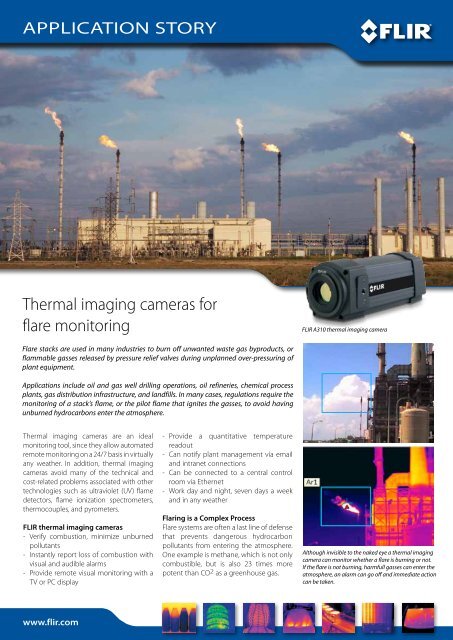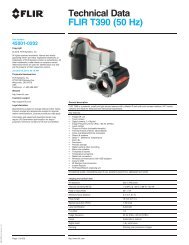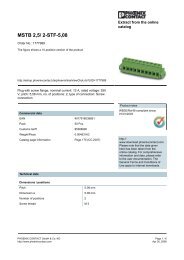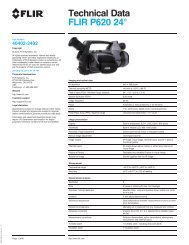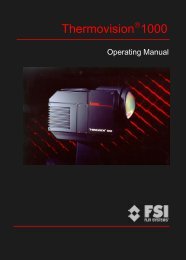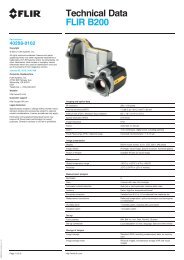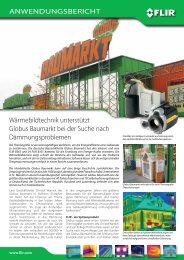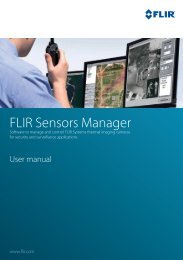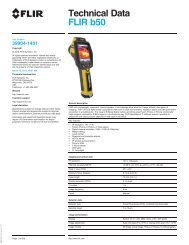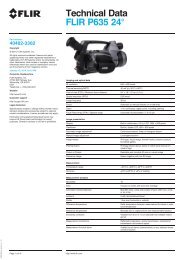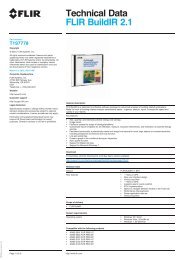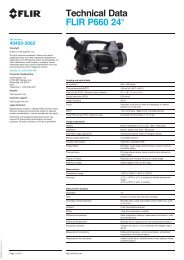Thermal imaging cameras for flare monitoring
Thermal imaging cameras for flare monitoring
Thermal imaging cameras for flare monitoring
You also want an ePaper? Increase the reach of your titles
YUMPU automatically turns print PDFs into web optimized ePapers that Google loves.
application story<br />
<strong>Thermal</strong> <strong>imaging</strong> <strong>cameras</strong> <strong>for</strong><br />
<strong>flare</strong> <strong>monitoring</strong><br />
FLIR A310 thermal <strong>imaging</strong> camera<br />
Flare stacks are used in many industries to burn off unwanted waste gas byproducts, or<br />
flammable gasses released by pressure relief valves during unplanned over-pressuring of<br />
plant equipment.<br />
Applications include oil and gas well drilling operations, oil refineries, chemical process<br />
plants, gas distribution infrastructure, and landfills. In many cases, regulations require the<br />
<strong>monitoring</strong> of a stack’s flame, or the pilot flame that ignites the gasses, to avoid having<br />
unburned hydrocarbons enter the atmosphere.<br />
<strong>Thermal</strong> <strong>imaging</strong> <strong>cameras</strong> are an ideal<br />
<strong>monitoring</strong> tool, since they allow automated<br />
remote <strong>monitoring</strong> on a 24/7 basis in virtually<br />
any weather. In addition, thermal <strong>imaging</strong><br />
<strong>cameras</strong> avoid many of the technical and<br />
cost-related problems associated with other<br />
technologies such as ultraviolet (UV) flame<br />
detectors, flame ionization spectrometers,<br />
thermocouples, and pyrometers.<br />
FLIR thermal <strong>imaging</strong> <strong>cameras</strong><br />
- Verify combustion, minimize unburned<br />
pollutants<br />
- Instantly report loss of combustion with<br />
visual and audible alarms<br />
- Provide remote visual <strong>monitoring</strong> with a<br />
TV or PC display<br />
- Provide a quantitative temperature<br />
readout<br />
- Can notify plant management via email<br />
and intranet connections<br />
- Can be connected to a central control<br />
room via Ethernet<br />
- Work day and night, seven days a week<br />
and in any weather<br />
Flaring is a Complex Process<br />
Flare systems are often a last line of defense<br />
that prevents dangerous hydrocarbon<br />
pollutants from entering the atmosphere.<br />
One example is methane, which is not only<br />
combustible, but is also 23 times more<br />
potent than CO 2 as a greenhouse gas.<br />
Although invisible to the naked eye a thermal <strong>imaging</strong><br />
camera can monitor whether a <strong>flare</strong> is burning or not.<br />
If the <strong>flare</strong> is not burning, harmfull gasses can enter the<br />
atmosphere, an alarm can go off and immediate action<br />
can be taken.<br />
www.flir.com
application story<br />
When this ratio is properly adjusted, it<br />
improves combustion and minimizes<br />
smoke. Upset conditions require immediate<br />
adjustment of the air or steam volume to<br />
maintain proper combustion. As a bonus,<br />
automated assist gas injection control can<br />
help avoid excessive steam consumption,<br />
and provide significant cost savings.<br />
The FLIR A310 <strong>cameras</strong> provide several<br />
features that facilitate automatic control. As<br />
a starting point, the camera senses flame<br />
temperature and size, key elements in a<br />
control scheme. This calibrated data can be<br />
communicated through the A310 Ethernet<br />
port to a PLC or PC running the assist gas<br />
control program, using either a wireless<br />
access point, fiberoptic cable, or CAT-6<br />
Ethernet cable.<br />
Schematical overview of a <strong>flare</strong> detection installation<br />
A plant manager needs to know<br />
immediately if <strong>flare</strong> stack combustion is<br />
lost, and get the flame reignited quickly to<br />
prevent a plant shutdown.<br />
Various technologies have been tried <strong>for</strong><br />
<strong>monitoring</strong> the pilot flame that ignites<br />
gas flow and detects the stack flame,<br />
with varying degrees of success. Many of<br />
these technologies are useless or poor at<br />
minimizing smoke from stake combustion,<br />
an important indicator of burn efficiency.<br />
One of the problems is that <strong>flare</strong> gas flows<br />
can range from low volumes during fuel<br />
gas purges in normal operations, to very<br />
large flows during emergency relief valve<br />
dumps or during total plant blowdowns.<br />
The size and brightness of the resulting<br />
stack flame, and the amount of smoke<br />
generated, depends on how much<br />
flammable material is released. Assist gases<br />
such as air or steam may be injected into<br />
the gas flow to improve combustion and<br />
help minimize smoke.<br />
FLIR thermal <strong>imaging</strong> <strong>cameras</strong> offer a<br />
solution<br />
FLIR thermal <strong>imaging</strong> <strong>cameras</strong> recognize<br />
the difference in the heat signature of<br />
a <strong>flare</strong> stack flame and the surrounding<br />
background (usually, the sky or clouds). In<br />
addition to detecting stack flame, these<br />
<strong>cameras</strong> can be positioned to monitor<br />
the igniter flame. Typically, <strong>cameras</strong> are<br />
mounted on a pedestal or other rigid<br />
structure in moisture resistant housings<br />
to protect them from harsh weather<br />
conditions.<br />
The camera’s spectral response and<br />
calibration allows it to see through moisture<br />
in the air to obtain a good image and<br />
relative temperature reading of the <strong>flare</strong><br />
stack or pilot flame. The images obtained<br />
with FLIR thermal <strong>imaging</strong> <strong>cameras</strong> even<br />
allow an observer to detect stack flame<br />
that might not be visible to the naked eye<br />
because of its composition or low gas flow<br />
volume.<br />
This overcomes problems associated with<br />
UV flame detectors, which can be blinded<br />
by smoke. <strong>Thermal</strong> and visual images can<br />
be transmitted in real time to a central<br />
control room as either analog or digitized<br />
data.<br />
Automated Control<br />
In addition to visual <strong>monitoring</strong> of stack<br />
flame and smoke, automatic control of<br />
the assist gas to waste gas ratio is possible.<br />
If data falls outside the user’s preset limits,<br />
the camera can send alarm signals to<br />
the control room via the data I/O port.<br />
In addition, A310 <strong>cameras</strong> can also be<br />
configured to automatically send numerical<br />
data and images via Ethernet to a PC via<br />
e-mail (SMTP) or FTP protocol whenever a<br />
data setpoint is reached, thereby creating a<br />
record <strong>for</strong> subsequent review.<br />
Flares invisible to the naked eye can be clearly seen on<br />
a thermal image.<br />
For more in<strong>for</strong>mation about thermal <strong>imaging</strong><br />
<strong>cameras</strong> or about this application,<br />
please contact:<br />
FLIR Commercial Systems B.V.<br />
Charles Petitweg 21<br />
4847 NW Breda - Netherlands<br />
Phone : +31 (0) 765 79 41 94<br />
Fax : +31 (0) 765 79 41 99<br />
e-mail : flir@flir.com<br />
www.flir.com<br />
T820230 {EN_uk}_A


